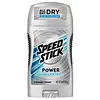What's inside
What's inside
 Key Ingredients
Key Ingredients

 Benefits
Benefits

 Concerns
Concerns

 Ingredients Side-by-side
Ingredients Side-by-side

Aluminum Zirconium Tetrachlorohydrex Gly
AstringentElaeis Guineensis Kernel Oil
EmollientStearyl Alcohol
EmollientCyclomethicone
EmollientC12-15 Alkyl Benzoate
AntimicrobialAluminum Zirconium Tetrachlorohydrex Gly, Elaeis Guineensis Kernel Oil, Stearyl Alcohol, Cyclomethicone, C12-15 Alkyl Benzoate, PPG-14 Butyl Ether, Hydrogenated Castor Oil, Hydrogenated Soybean Oil, PEG-8 Distearate, Behenyl Alcohol, Citric Acid, Pentaerythrityl Tetra-Di-T-Butyl Hydroxyhydrocinnamate
Aluminum Zirconium Tetrachlorohydrex Gly 18.2%
AstringentPPG-14 Butyl Ether
Skin ConditioningStearyl Alcohol
EmollientCyclopentasiloxane
EmollientIsopropyl Palmitate
EmollientParaffinum Liquidum
EmollientHydrogenated Castor Oil
EmollientPEG-8 Distearate
EmulsifyingParfum
MaskingPolyethylene
AbrasiveBHT
AntioxidantAlpha-Isomethyl Ionone
PerfumingBenzyl Alcohol
PerfumingCitral
PerfumingCitronellol
PerfumingCoumarin
PerfumingEugenol
PerfumingGeraniol
PerfumingHexyl Cinnamal
PerfumingIsoeugenol
PerfumingLimonene
PerfumingLinalool
PerfumingAluminum Zirconium Tetrachlorohydrex Gly 18.2%, PPG-14 Butyl Ether, Stearyl Alcohol, Cyclopentasiloxane, Isopropyl Palmitate, Paraffinum Liquidum, Hydrogenated Castor Oil, PEG-8 Distearate, Parfum, Polyethylene, BHT, Alpha-Isomethyl Ionone, Benzyl Alcohol, Citral, Citronellol, Coumarin, Eugenol, Geraniol, Hexyl Cinnamal, Isoeugenol, Limonene, Linalool
Ingredients Explained
These ingredients are found in both products.
Ingredients higher up in an ingredient list are typically present in a larger amount.
We don't have a description for Aluminum Zirconium Tetrachlorohydrex Gly yet.
Hydrogenated Castor Oil is created by adding hydrogen to castor oil. This helps stabilize the castor oil and raises the melting point. At room temperature, hydrogenated castor oil is solid.
Castor Oil helps moisturize the skin. It is rich in a fatty acid called ricinoleic acid. This fatty acid helps prevent moisture loss on the skin. This helps keep your skin soft and hydrated. Ricinoleic acid also has anti-inflammatory and pain reducing properties.
As a wax-like substance, Hydrogenated Castor Oil acts as an emollient. Emollients help keep your skin stay soft and smooth by creating a barrier. This barrier helps trap moisture.
Hydrogenated Castor Oil may not be fungal-acne safe. We recommend speaking with a professional.
Learn more about Hydrogenated Castor OilPEG-8 Distearate isn't fungal acne safe.
We don't have a description for PPG-14 Butyl Ether yet.
Stearyl Alcohol is a type of fatty alcohol from stearic acid. It is a white, waxy compound used to emulsify ingredients.
Fatty Alcohols are most often used as an emollient or to thicken a product. Emollients help soothe and hydrate the skin by trapping moisture.
They are usually derived from natural fats and oils and therefore do not have the same drying or irritating effect as solvent alcohols. FDA allows products labeled "alcohol-free" to have fatty alcohols.
Learn more about Stearyl Alcohol